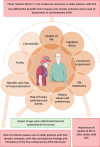Is the contemporary care of the older persons with acute coronary syndrome evidence-based?
- PMID: 35919658
- PMCID: PMC9242048
- DOI: 10.1093/ehjopen/oeab044
Is the contemporary care of the older persons with acute coronary syndrome evidence-based?
Erratum in
-
Corrigendum to articles in EHJ Open missing data availability statements.Eur Heart J Open. 2024 Jan 16;4(1):oead137. doi: 10.1093/ehjopen/oead137. eCollection 2024 Jan. Eur Heart J Open. 2024. PMID: 38230360 Free PMC article.
Abstract
Globally, ischaemic heart disease is the leading cause of death, with a higher mortality burden amongst older adults. Although advancing age is associated with a higher risk of adverse outcomes following acute coronary syndrome (ACS), older patients are less likely to receive evidence-based medications and coronary angiography. Guideline recommendations for managing ACS are often based on studies that exclude older patients, and more contemporary trials have been underpowered and produced inconsistent findings. There is also limited evidence for how frailty and comorbidity should influence management decisions. This review focuses on the current evidence base for the medical and percutaneous management of ACS in older patients and highlights the distinct need to enrol older patients with ACS into well-powered, large-scale randomized trials.
Keywords: Acute coronary syndrome; Coronary angiography; Myocardial infarction; Older adults; Percutaneous intervention.
© The Author(s) 2021. Published by Oxford University Press on behalf of the European Society of Cardiology.
Figures







References
-
- World Health Organisation. Ageing and Health. 2018; 2021.
-
- Gale CP, Cattle BA, Woolston A, Baxter PD, West TH, Simms AD, Blaxill J, Greenwood DC, Fox KA, West RM. Resolving inequalities in care? Reduced mortality in the elderly after acute coronary syndromes. The Myocardial Ischaemia National Audit Project 2003-2010. Eur Heart J 2012;33:630–639. - PubMed
-
- Tahhan AS, Vaduganathan M, Greene SJ, Alrohaibani A, Raad M, Gafeer M, Mehran R, Fonarow GC, Douglas PS, Bhatt DL, Butler J. Enrollment of older patients, women, and racial/ethnic minority groups in contemporary acute coronary syndrome clinical trials: a systematic review. JAMA Cardiol 2020;5:714–722. - PubMed
-
- Alexander KP, Newby LK, Cannon CP, Armstrong PW, Gibler WB, Rich MW, Van de Werf F, White HD, Weaver WD, Naylor MD, Gore JM, Krumholz HM, Ohman EM. Acute coronary care in the elderly, part I: non-ST-segment-elevation acute coronary syndromes: a scientific statement for healthcare professionals from the American Heart Association Council on Clinical Cardiology: in collaboration with the Society of Geriatric Cardiology. Circulation 2007;115:2549–2569. - PubMed

